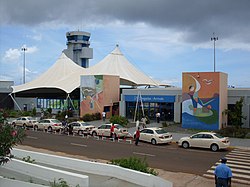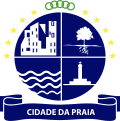Achada Grande Tras
Achada Grande Tras | |
|---|---|
Neighborhood | |
 Nelson Mandela International Airport, the airport of the island of Santiago | |
 | |
| Country | Cape Verde |
| Island | Santiago Island |
| City | Praia |
| Postal code | 7600 |
| Website | www.cmpraia.cv |

Achada Grande Tras (meaning the rear portion of Achada Grande, former spelling: Achada Grande Trás) is a volcanic plateau and a subdivision in the east of Praia in the island of Santiago, Cape Verde and forming the easternmost neighborhood. It is the largest neighborhood in Praia being about 25 square kilometres (9.7 sq mi), 6 km long, and 4 km wide. The highest point is about 120 meters at the extinct volcano, the elevation at the center is about 55 meters, the lowest point is the Atlantic and the Praia Harbor. Other elevations are 67 meters at Monte Faxo, 110 meters at the extinct volcano, 80 to 100 meters at the airport, about 70 meters at Adega and 105 meters at the northwesternmost portion near the Circular Road (EN1-ST06).
Bordering neighbourhoods include Achada Grande Frente and Lem Ferreira and Castelão-Cova Mendes to the west, to the north is São Tomé subdivision. The Atlantic dominates the east and the west.
The center of the neighborhood overlooks the Atlantic Ocean on either sides and has a few ravines. Lesser sports facilities dominates the area.
History

Portugal never took part in the Anglo-French War which happened between 1778 and 1783 and was a neutral country. The Battle of Porto Praya which involved Great Britain and France took place at the harbor on April 16, 1781, it occurred south of Achada Grande, about 300 to 400 feet (about 100 meters) south, ten British convoys were next to the island, seven were in the vicinity of the two headlands of Ponta de Visconde.
Agriculture dominated the area up to the 2010s, but urban sprawl of Praia spread to the area in the 1970s. It was not fully urbanized until the early 2010s in the southern portion. Agricultural lands and some forest groves dominate the remainder in the northwest. Urban developments continued up to the present day in the center and now under development especially at the northern estates next to an extinct volcano and a new subdivision, Ponta das Bicudas in the south which started construction in 2014 and is still continuing, except for the east part, most of the promontory has been terraformed and will probably feature hotels and villas.

Once located at Gamboa, the port along with its customs house and ferry services transferred 1 km to the east at the area of Ponta de Visconde in the south. The port underwent expansion in 2009 and finished in 2013 with additional spaces for cargo boats and ferry services in the west. It also added the truck-cargo lots in the east and what was the custom house became a large custom station in the east and connects with the road to Rua de Aeroporto and Avenida de Aristides Pereira. Since the expansion, Ponta do Ponto is the southernmost point of the area which replaced Ponta das Bicudas and is more south than Ilhéu de Santa Maria, the port size is even larger than the nearby islet. Ponta do Porto was once the third southermnost point.
Santiago Island's first airport opened in 1961, the first prominent feature in the area located in the western edge, Francisco Mendes International Airport functioned until 2004, 3 kilometers to the north-northeast, the airport would be relocated with larger terminals, cargo buildings and a longer runway measuring more than 2 kilometers.
The Adega sports complex was constructed in the 2010s and was completed in 2012,[1] several clubs including Travadores practices at the field.
About Achada Grande Tras

It has a couple of promontories, one once called Ponta de Visconde, now called Ponta de Porto Novo, pushed a kilometer south with its port expansion and forms a part of the Port of Praia and Ponda das Bicudas, the island's southwesternmost point which are surrounded by steep cliffs 10–20 meters tall. Praia do Portinho (Portuguese for little gates) is a small port just east of the port. Other geographical features is a small extinct volcano, the southern portion is carved to developments. Another is a hill named Monte Faixo. Elevation up to 500 meters into the sea is no deeper than 3 to 5 meters below sea level; about 2 kilometers distant the depth is 1,000 meters and further the deepest about 2,500 to 3,000 meters. Two streams are in the northern portion including Ribeirões da Pedro and Curral Velho in the north, the latter is the approximate boundary with the settlement of São Tomé.
Numerous streets includes Rua de Aerporto the road connecting Praia with the airport and an alternate road with the north of the island. Avenues includes John F. Kennedy and Aristides Pereira (part of EN1-ST06), the arterials serves between the port and the north and the west of the island via the circular road (opened in 2008) and Hipólito Ferreira in the east inside the center. In the earlier times, the street now known as Rua do Aeroporto (part of EN1-ST06) was just a small road linked to Praia do Pontinho; later it became shortened.
Near the airport's entrance is the Monument to Emigrants (Monumento ao Emigrante) at the roundabout at the junction of Avenida Aristides Pereira, the Circular Road (part of EN1-ST06) and the road to the airport. It is in honor of the great poet Eugénio Tavares and the poem "Si ka badu ka ta biradu".
Its football (soccer) club is Unidos do Norte, a club founded in 2005 after the merger of Paiol and Praia Rural, sometimes based in Achada São Filipe it is based in the neighborhood and has a field west of the neighborhood in Achada Grande Frente. Unidos do Norte no longer include the south of Achada Grande Tras, Asa Grande is the main football club of the neighborhood.
Located at the airport is the headquarters of TACV.
One of four variants of tabanka is the Achada Grande variant which is common in nearby Achada Grande Frente and other parts of the city, in the northern part.[2]
Landmarks and points of interest
- Complexo Desportivo Adega - center
- Nelson Mandela International Airport, the city's and the island's airport - north
- Port of Praia
Panoramics
Panoramics includes most of the city of Praia up to around Palmarejo, the southeast of the island and Pico da Antónia, the island's summit.
Transportation
A few transit lines passes through the plateau often or sometimes, the last three do not cross by the Atlantic, they include:[3]
- Plateau – Aeroporto
- Palmarejo - Plateau – Achada Grande
- Plateau – Port of Praia
References
- ^ Inauguração Complexo Desportivo de Achada Grande Trás > C M Praia Archived 2013-11-07 at the Wayback Machine
- ^ Gonçalves, C. F. (2006). Kab Verd Band.
- ^ "Solatlântico reforças linhas da Praia com mais 10 autocarros". A Semana (in Portuguese). 2014.


